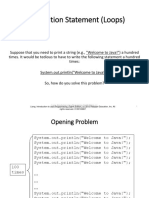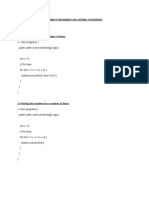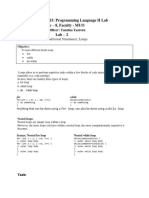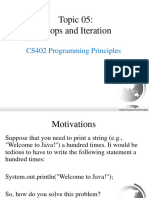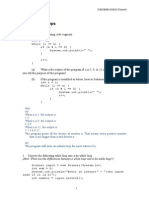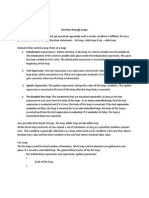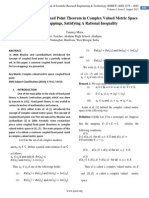CSE 11 – Intro to Programming, Expedited Week 2 - Monday
Note 6 – break, continue, nested for
1. Loop recaps
1. initialization exp evaluated first
2. loop condition evaluated; if false goto next statement after loop block
3. execute loop body
4. execute loop exp; goto 2.
Nested For Loops
public class MultiplicationTables {
public static void main( String[] args ) { Output:
1 x 1 = 1
//complete me
1 x 2 = 2
1 x 3 = 3
1 x 4 = 4
1 x 5 = 5
1 x 6 = 6
1 x 7 = 7
1 x 8 = 8
1 x 9 = 9
1 x 10 = 10
}
------------
}
2 x 1 = 2
.
.
.
For loop variants
------------
for (i = 0, j = 10; i < j; i++, j--) {
statements;
}
for ( ; k-- > j; ) { for ( ; ; ) { while ( true ) {
statements; statements; statements;
} } }
- this is a good candidate for a while loop - forever loop - forever loop
int n = 4; A. 4
int x = 0;
while(n > 0) {
B. 6
for(int i = 0; i < n; ++i) { C. 7
++x; D. 8
} E. This will cause a compile error
n /= 2;
}
//value of x?
1
CSE 11 – Intro to Programming, Expedited Week 2 - Monday
2. break and continue
break and continue statements allow us to alter the normal flow of a loop
• break: when executed, the inner-most loop that contains the break statement will be exited immediately.
• continue: when executed, the remainder of the current iteration will be skipped.
for (int i = 0; i < 10; i++){ How many times is continue statement
if (i++%3==0) { executed?
continue;
}
A. 0
if (--i%2==0){ B. 1
break; C. 2
} D. 5
System.out.println(i); E. 10
}
3. String in Java (https://docs.oracle.com/javase/10/docs/api/java/lang/String.html)
String is a data type in Java that is used to store a sequence of characters. It is an Object type, not a primitive
- string concatenation operator ( + )
- only object type with which Java provides literals "Hello World"
- equals() [vs. ==], length(), charAt(), and many more
What is the output of the following code snippet?
String name = "Hazel";
System.out.println("name = " + name);
System.out.println("length = " + name.length());
//substring is left inclusive, right exclusive
System.out.println(“substring = “ + name.substring(2, 4));
System.out.println("name starts with = " + name.charAt(0));
System.out.println(“loc for a = “ + name.indexOf(‘a’));
System.out.println("name ends with = " + name.charAt(name.length() - 1));
StringBuilder: Another type to represent string information but it is mutable.
public class Tester{
public static void main(String[] args){
//Code A: What does the code print?
StringBuilder b=new StringBuilder(“hello”);
b.append(“ there!”);
System.out.println(b.toString());
A. Both print hello there!
//Code B B. Both print hello
String s=new String(“hello”); C. A prints hello and B prints hello there!
s.concat(“ there!”); D. A prints hello there! and B prints hello
System.out.println(s); E. Compiler error for A as we need to import
}
} StringBuilder


















